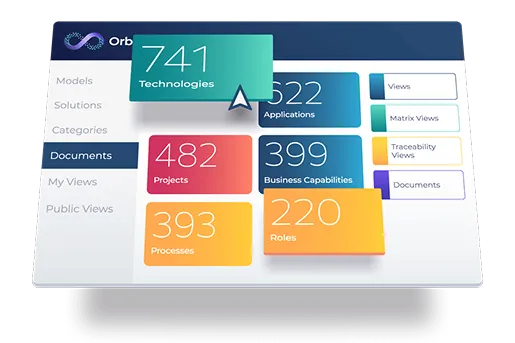We aim to take all our initiatives through OrbusInfinity, make it a part of every project.
Cambridge Assessment is a department of the University of Cambridge. Formed in 1858 it is one of the world’s first assessment organisations that today provides educational assessment for around 8 million learners in over 170 countries.
The Challenge
Last year Cambridge Assessment produced half a billion sides of confidential question papers, scanned 36.5 million sheets of exam scripts, and handled over 50 million website visits. Examination schedules and results release dates mean immovable deadlines, and a reliance on the availability of core IT systems.
There are hundreds of systems supporting a complex global infrastructure that delivers a very wide range of products for paper and digital assessments.
Historically, this took a lot of effort for the small architecture team. Before introducing OrbusInfinity, there was a constant challenge to manage technology updates and implement changes which consumed a lot of effort.
Each individual project would have its own repository that would follow project documentation standards and focus on ensuring information was available for the support teams. Architectural information was distributed across several locations in many different MS Office suite documents.
It could also take a lot of effort to re-use or re-purpose designs made for earlier projects as there was no central control of the models or component names.
As the organization looked to modernize the IT estate, it became apparent that they needed a centralized tool.
The Solution
Selecting OrbusInfinity
When they set out to procure a tool, the architecture team set a few key requirements. Any solution had to be quick to adopt and usable without a significant training period. OrbusInfinity stood out because of the way it leverages and enhances Microsoft technologies such as SQL Server for the central repository’s database, the Office suite for documentation, and Visio as a modelling environment. Visio was particularly crucial, as it afforded fantastic usability and flexibility in terms of tailoring outputs, as well as a familiar look and feel.
This in turn gave users a gentler learning curve, and minimized training overheads.
Secondly, the department wanted something that was easily scalable from the initial usage for solution and infrastructure projects, to today where it is used for modelling data architecture, business capabilities, integration diagrams, business processes and roadmaps for every system used in the organisation.
OrbusInfinity’s versatility scored highly. Its breadth of capabilities spanning multiple domains including Enterprise Architecture and Business Process Analysis set it apart from competitors. The central repository offered great functionality for building and managing an architecture thanks to its framework alignment, artefact reuse and governance features. At the same time, it empowered architects to do more by facilitating modelling, offering alignment to BPMN 2, and eliminating the need to update models manually.
The final key requirement was solid content sharing capabilities. If architecture materials cannot be easily shared and understood, then they are useless. The great looking outputs that OrbusInfinity offered reassured the team of the big role the visual material would play to communicate changes across the estate.
The Result
OrbusInfinity has enabled the architecture and analysis teams to be more organized. They now do more in less time, with greater transparency.
The OrbusInfinity platform helped Cambridge Assessment to create a collaborative environment and encourage dialog whenever a new initiative needs attention.
For the future, the architecture team’s objective is to extend OrbusInfinity’s use cases in the enterprise and unite stakeholders around it as they seek to create more value within the IT department.
Why OrbusInfinity?
Meeting all these requirements better than competitors highlighted OrbusInfinity as the clear winner. But there was an extra factor that contributed to the decision – the presales experience.
Cambridge Assessment were helped throughout the process by a knowledgeable sales consultant. Demonstrations showed how the solution handled their specific requirements. Then a defined free Proof of Concept with a dedicated environment set up for their team allowed the architects to experience exactly how OrbusInfinity would perform.
What’s more, Orbus Software facilitated the liaison with another education organization that was using OrbusInfinity in order to grant them access to as much pre-purchase information and hands on recommendations as possible.
After installation and deployment, the team took ownership of the platform and created a sandpit and two libraries – an As Is and a To Be – and started to manage their technical and solution architectures.
Their goal was to get off the ground as soon as possible, which is why the team followed a philosophy of “utility over all-inclusiveness” and started on the areas with the largest business impact first.
Having a unified location where everyone could work together and reuse sanctioned artefacts was an immediate benefit, reducing effort and eliminating duplication. OrbusInfinity’s comprehensive support for frameworks helped users keep to a common standard, while its traceability, workflow and permission features enabled admins to safeguard the integrity of the captured content.
The sandpit environment allowed anyone to experiment with new models, learning the ArchiMate modelling language and testing concepts without impacting the operational data sets.
OrbusInfinity quickly started to play a part in all IT projects, as it provided the valuable diagrams to accompany the necessary documentation. By helping the roadmap specialist create capability models and roadmaps, the platform has allowed the entire department to gain a solid understanding of their application landscape and today support rationalizing efforts.
A custom swim lane-based language was developed in OrbusInfinity to support road mapping activities.
OrbusInfinity Portal proved to be advantageous immediately, with the architecture team leveraging it to publish models by sharing the URL and gather feedback stakeholders.
When the business analysts started to use OrbusInfinity to share their process models with the business stakeholders it cut down the cycle-time for updates and helped co-ordinate changes as the business teams could submit comments directly on the models.
OrbusInfinity has enabled the architecture and analysis teams to be more organized. They now do more in less time, with greater transparency.
The OrbusInfinity platform helped Cambridge Assessment to create a collaborative environment and encourage dialog whenever a new initiative needs attention.
For the future, the architecture team’s objective is to extend OrbusInfinity’s use cases in the enterprise and unite stakeholders around it as they seek to create more value within the IT department.











